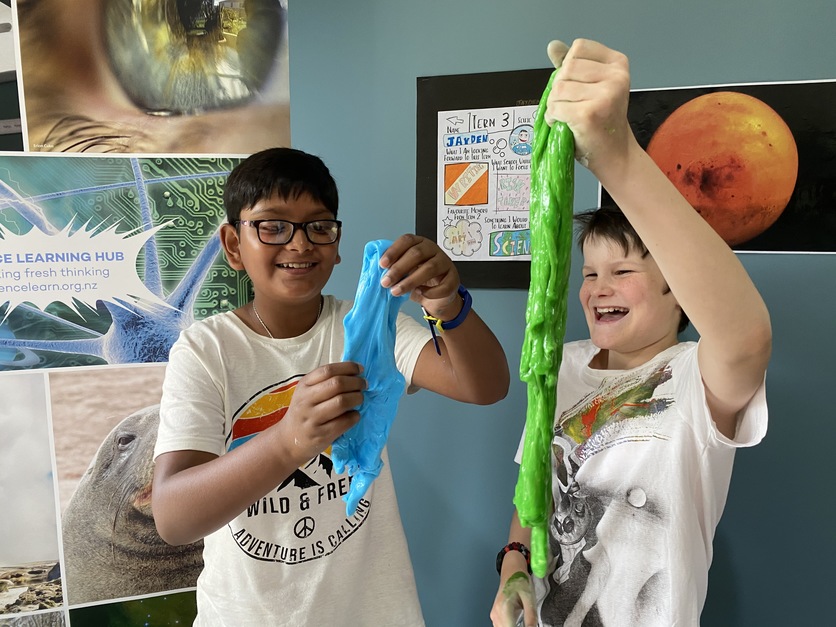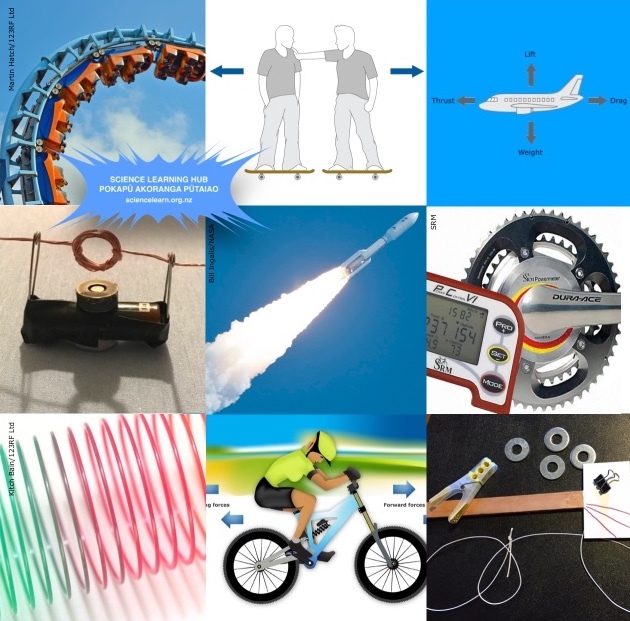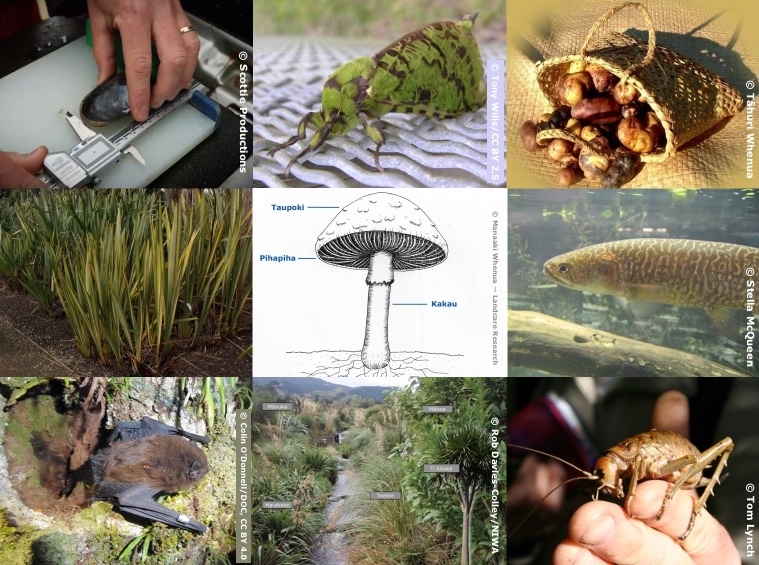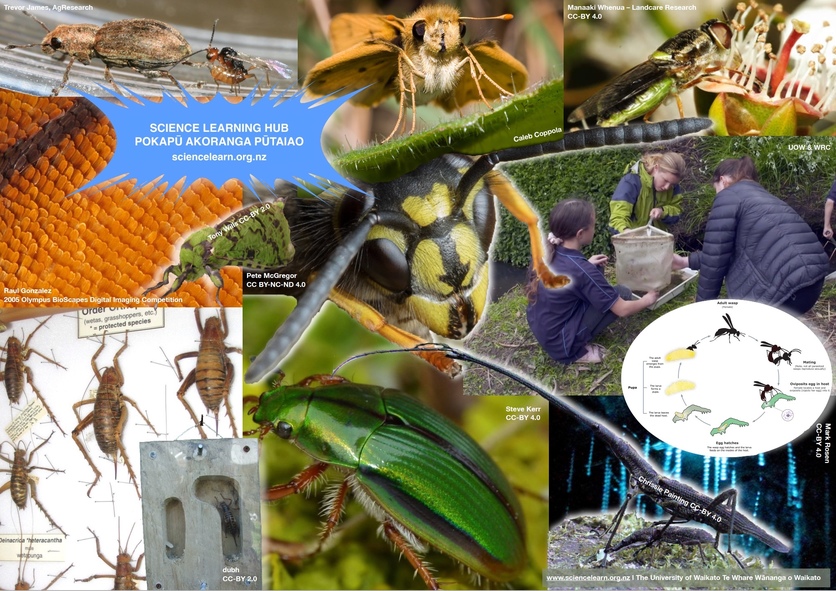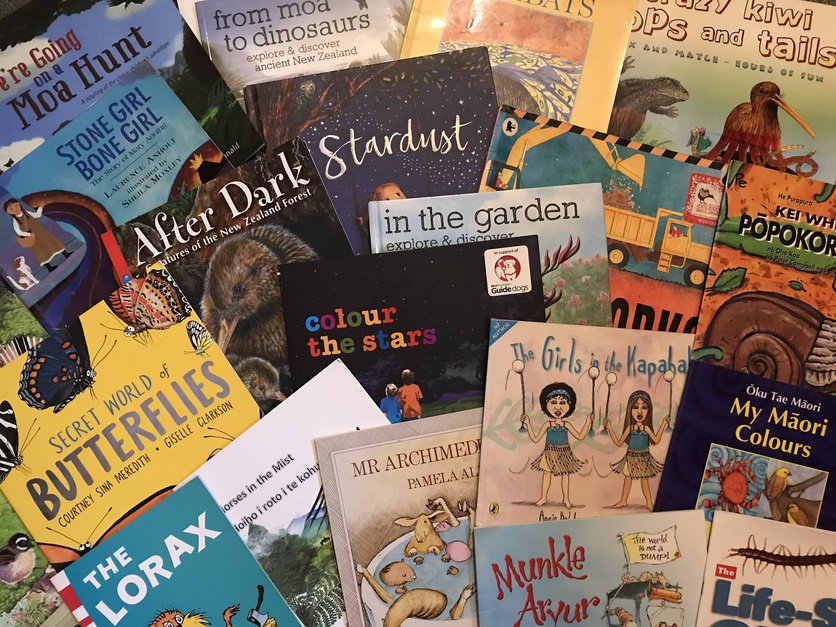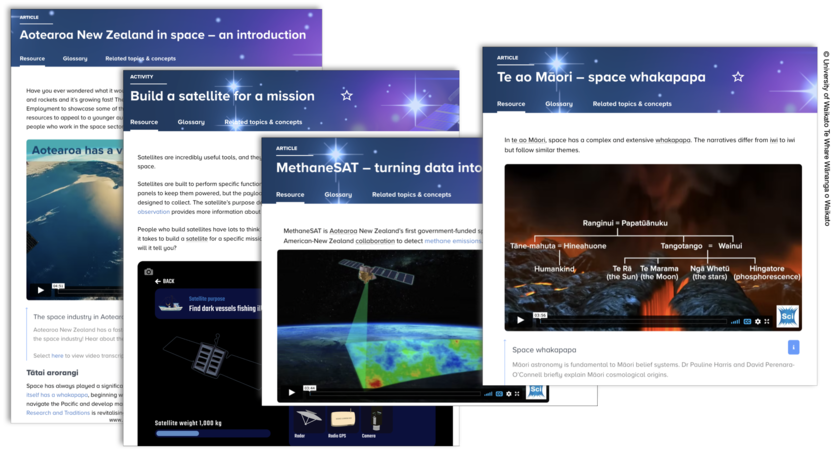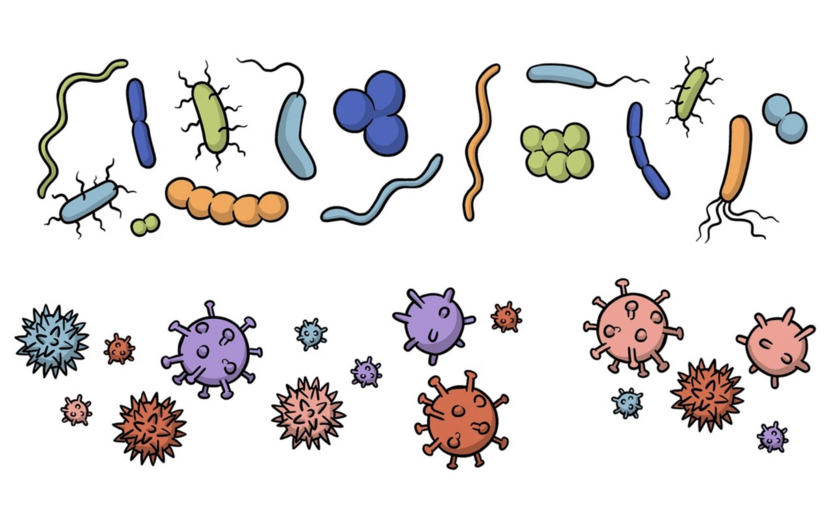The Science Learning Hub is instrumental in helping primary teachers come to grips with science and then to deliver exciting and engaging science activities and learning to students. Introducing our PLD explains the various components the Hub has to offer – webinars, planning and pedagogy.
If you've not used the Hub before, consider beginning with this article How the Hub can help – it’s full of short, helpful videos. Our webinar Science support at your fingertips gives you an overview of the site's newest capabilities.
Check out these professional development sessions (with resources) to help you with the various topics offered.
- Seaweek
- Primary Science Week
- Climate change
- Conservation
- Get kids excited about science
- Material World and Physical World
- Te reo Māori and mātauranga Māori resources
- What does the Hub look like in the classroom?
- Teachers adapting the Hub: Food webs
- Teachers adapting the Hub: Understanding earthquakes in the primary classroom
- Water quality
- Bird conservation and literacy
- Insects
- Teachers using the Hub: Butterflies and citizen science
- Teachers using the Hub: Light and sight in the classroom
- Teachers making links to numeracy and literacy
- Using drama in science teaching
- Teachers using the Hub: One website, many uses
- Space and astronomy
- Science capabilities and competencies
- Scientists in the classroom
- Citizen science
- The science of superbugs
- Vision 20/20
- Digital tools and science learning
- Drawing for thinking
Seaweek
Seaweek – New Zealand’s annual national week that focuses on learning about the sea – is usually held in February/March. This is prime time for a Living World science unit on our oceans.
We have three PLD webinars: Seaweek 2015 which focuses on the nature of science and teacher ideas and Seaweek 2016 which focuses on marine content and planning. With Seaweek 2018, we've branched out to feature resources from DOC and Young Ocean Explorers. Remember that these can also be used any time when the sea is your science focus. Seaweek resources is a handy article that curates a wide range of helpful Hub resources.
Learn about the dog death mystery on Auckland beaches – and how our investigative scientists solved the mystery.
Check out the science ideas and concepts concerning marine life – such as classifying, adaptations, environmental issues, food webs and human impacts.
Teaching activities include a game about tracking marine toxins (the interactive Bioaccumulation in the sea goes well with this), a card sorting game on habitats Where do I live?, hands-on fun cleaning up oil from water and making food webs using marine organisms cards.
Estuaries – a context for learning is a one-stop shop for learning about these important places. It has links to scientific, cultural and economic aspects of estuaries.
Awesome thanks. Some great resources to use.
Teacher
Primary Science Week
The Hub teams up with the New Zealand Association of Primary Science Educators (NZAPSE) to promote and support the annual Primary Science Week.
The Get inspired about running Primary Science Week webinar was run in 2022 and is a great place to start with – it's full of ideas, resources and inspiration for running your own primary science week.
In this 2024 webinar Fun and safety with primary science, the NZAPSE educators share resources and advice for staying safe while having fun with science.
In 2020 we ran the Sounds of Aotearoa webinar with Greta Dromgool and educators from NZAPSE that explored fun ways to learn and teach about sound.
The 2019 theme was all about the periodic table and chemistry – have a look at our webinar Chemistry in the primary classroom for some hands-on activity ideas.
In 2018, the theme was eco-champions, science in action and we enjoyed working with the Department of Conservation. The resources listed below under the conservation heading will be of help.
Brilliant session, perfect mix of science and teaching ideas.
Teacher
In 2017, with a focus on road safety, we created a simple activity to investigate car safety features.
Soil was the theme for 2016 and we produced two webinars Soil – a focus for PSW and Soil activities and science capabilities.
Climate change
Our webinar Understanding the basics of climate change provides teachers with the key science ideas they need to teach climate change. Part two of this series, Exploring climate change education in primary schools shows how you can build student understanding.
Conservation
Conservation is great for cross-curricular learning opportunities. The article Conservation resources – planning pathways has pedagogical advice and an interactive planning map (as below) that groups Hub resources into key science and teaching concepts.
Our PLD session on conservation covers how there are many student activities on the SLH about conservation. Science concepts from this PLD session include ideas such as bioindicators and biodegradability, classifying and identifying ferns, solar energy, and river and marine ecosystems and human impact on them.
Fun student activities include making lizard-friendly habitats, an outdoor game that teaches about bird migration, simulating a greenhouse effect, melting chocolate biscuits to learn about heat energy, making a solar oven from a pizza box and developing classification systems.
We have teamed up with the Department of Conservation to produce two webinar series.
The first explores whio as a context and links inquiry with conservation: Diving into inquiry, Why learn about whio?, Inquiry outside the classroom and Taking action for conservation. The Hub has several articles and activities to support these webinars.
That has been excellent – I am going to be sharing this with teachers at an Enviroschools Cluster meeting.
Teacher
The second series focuses on conservation education, using the DOC In your environment resources and includes: Eco-explorers, Our native trees, Pest detectives and Eco-champions.
Making use of topical issues is another way to get students interested in science. Climate change is a wicked problem and an issue students feel strongly about. We provide some ideas on how to channel this interest in the article Climate change resources – planning pathways. The interactive planner groups resources into key science concepts.
Get kids excited about science
Engage your kids with science! Give them a passion for learning. In this session, primary school teacher Andy Peart describes his favourite Science Learning Hub activities – ones he loves to teach and his students love to learn. These include exploding flour, putting out fires, observing candles, water rockets, canister rockets, balloon cars, UV beads and racing marbles in strange liquids.
The webinar Kitchen science explains how to use simple kitchen ingredients and equipment to deepen students' understanding of science in everyday contexts. One fun activity is making ice cream.
Our webinar Observology for the classroom shows you how observing nature can lead to engaging science learning.
I failed science at high school – like I wasn’t very good at science, but the Science Learning Hub stuff that I’ve been able to pick up, I can do all of it and I’m not the smartest character.
Presenter
Material World and Physical World
Sometimes primary teachers struggle to find ideas, contexts or topics for teaching the Material World and Physical World strands from the curriculum. These PD sessions offer a number of ideas for teaching from these strands.
I found this session really helpful, and I will definitely be using the Science Learning Hub. Thanks very much.
Teacher
Topics/contexts (and student activities) presented in the Material World PD session include fire, biodegradability, non-Newtonian fluids, water and chemicals (toxins).
Plastics and issues associated with their use span several aspects of the NZC. We cover these in the article Thinking about plastic – planning pathways. The interactive planner has useful pedagogical and Nature of science information.
Exploring magnetism is full of simple investigations that help teachers move from playing with magnets to developing students' science capabilities and understanding.
Our Physics made simple webinars – force and motion, gravity and waves take teachers step by step through the basics of teaching these concepts using everyday examples.
The Biospife story has some great aspects for primary children – my daughter’s class looked at it in year 3, and it was a hit.
Participant
Topics, contexts and student activities presented in the Physical World PD session include Flight, Light and sight, Fire, Future fuels, Rockets, The noisy reef, You, me and UV, Harnessing the Sun and Tsunamis and surf.
Our Physics made simple – force and motion session takes teachers step by step through the basics of teaching these concepts using everyday examples.
We have also have these useful one-stop-shop articles that curate our resources in one handy place for:
Physical World:
Material World:
Te reo Māori and mātauranga Māori resources
The Hub has a range of resources to support teachers to bring te reo Māori and contextual mātauranga Māori into their classrooms.
See our professional development webinars for further support:
- Opportunities for using te reo Māori – explores ways to incorporate te reo Māori alongside teaching science.
- Whakanui pūtaiao – focuses on including mātauranga in the primary classroom.
- Mātauranga Māori – unpacks important ideas teachers need to be aware of when including this in their classroom and is full of ideas and inspiration.
- Mātauranga and the Living World and Te Repo – wetlands as a context for learning share a large number of resources to support these areas of the curriculum.
- Tame Malcolm – indigenous pest management discusses how science and mātauranga can work together.
- Local curriculum, mātauranga and science – the Ministry of Education’s current PLD priorities include local curriculum design and growing cultural capability, what does this mean for science?
- Te Kāhui o Matariki and the environment – unpacks ideas connected to the Environment Aotearoa 2022 report and Te Kāhui o Matariki.
- Picturebooks for Matariki – discover the power of picturebooks to support te reo Māori and science learning.
- Kaitiakitanga with Tame Malcolm – Tame shares his understanding of kaitiakitanga.
- He whetū ki te rangi, he waka ki te moana – Dr Haki Tuaupiki speaks about Māori voyaging and navigation.
- He rauemi reo Māori mō ngā rākau – Te reo Māori plant resources – this webinar showcases bilingual resources developed alongside students, botanists and te reo Māori experts.
- Exploring mātauranga in the classroom – Chloe Stantiall, a year 5–6 kaiako at Silverdale Normal School, shares her experiences and insights from a week-long teaching and learning sequence about kōwhai.
Thank you so much. An amazing kete of resources.
Teacher
What does the Hub look like in the classroom?
This session demonstrates what it looks like to plan using the Hub and how you might adapt resources for your students.
Teachers adapting the Hub: Food webs
If you want to focus on food webs, check out the food webs PD session. Candy Hart talks about how she taught food webs using SLH resources and then encouraged her students to transfer their knowledge and make food webs based on their surrounding area.
I have also used the article in reading. I love the scientific vocabulary they learn.
Teacher
Teachers adapting the Hub: Understanding earthquakes in the primary classroom
Angela Schipper talks about how she adapted SLH material on earthquakes to suit year 4 students. Angela goes through a step-by-step process of how she developed the learning for her students. She looked at what her students already knew and what she needed to learn to be able to teach this topic. Angela used the SLH to find images, scientific language, science ideas and concepts about earthquakes, video clips, ideas about modelling and lots of hands-on activities – some of which involve food (a strong motivating factor!).
The Hub offers interactive planning pathways – visual gateways to collections of articles, mulimedia and actvities. They also include information regarding the NZC, nature of science, the science capabilities and key science concepts. Explore earthquakes and their cousins volcanoes.
It’s a really good – nice – use of examples. Great for the classroom. I liked your edible Earth idea. I’m motivated by food as well [as the children].
Teacher
Water quality
Issues around water and farming have featured in the news quite a bit lately. In this PLD session, Exploring water pollution Angela Schipper helps teachers to see what the issues are by first helping them understand the scientific view of the water cycle and then presenting some activities that help students see how water pollution comes about.
Great resources and information.
Teacher
Exploring our urban and rural waterways is a fantastic way to get students engaged in the world around them while developing their science capabilities. In this session you will be guided on how to support students to use a variety of water quality indicators to gather data about a local stream. Resources showing step-by-step instructions, protocols, recording sheets and how-to videos for monitoring stream health are shared.
Teachers using the Hub: Bird conservation and literacy
With the recent push for literacy and numeracy in primary schools, this PD session is timely and helpful, showing how science can be incorporated into literacy teaching. Kim MacPherson has a passion for our native birds – teaching her students about them and instilling in the students a love for these birds while honing their reading skills.
Thank you for the presentation. A great insight into the Science Learning Hub and all its classroom possibilities.
Teacher
The webinar Te Tatauranga o ngā Manu Māra o Aotearoa – The New Zealand Garden Bird Survey shares how students can be involved in New Zealand's longest running citizen science project.
Insects
Insects are fascinating and provide a great context for primary science. Learn from two of New Zealand’s amazing entomologists in our webinar All about insects.
See this useful one-stop-shop article Living World – Insects – it curates all our insect resources in one handy place.
Teachers using the Hub: Butterflies and citizen science
How about chasing butterflies over the summer months? Angela Schipper shares how she taught her students to be citizen scientists by showing them how to tag butterflies for the Monarch Butterfly New Zealand Trust.
Thanks, this was very informative.
Teacher
Teachers using the Hub: Light and sight in the classroom
This Physical World PD session focuses specifically on light and sight. Secondary teacher Steve Chrystall and primary teacher Miel MacLean talk about how they have used this SLH context (Light and Sight) in their classrooms. They both used the same material – adapting it to suit their age groups. They used the same student activities – finding that their students particularly enjoyed the Light and Sight interactive, a hands-on activity about spearfishing, making pinhole cameras and investigating reflection using a dark box, objects to put in the box and a torch.
Thanks for the dark box – some great ideas – often can’t do some of those darkroom activities – thanks Steve.
Teacher
Teachers making links to numeracy and literacy
Watch these videos to find out how teachers incorporated literacy and numeracy into their science programmes:
- Integrating numeracy and literacy
- Integration of e-learning tools
- Rockets – using the Hubs
- Students find things on their own level
The Hub produced a series of webinars with a focus on literacy. Two of interest to the primary sector are: Science and literacy – making connections and Fostering literacy through primary science. Presenter Anne Barker's activity, Newsboard for science, prompts students to think scientifically while being actively engaged in building literacy skills.
In the webinar Science through picture books, Dr Nicola Daly discusses the importance of picture books and demonstrates how they can be used to support science learning. The webinar Picturebooks for Matariki supports, also with Dr Daley, supports teachers to deepen our understanding of Matariki and provides links between picturebooks, te reo Māori and a range of science ideas from moon phases to star formation.
Using drama in science teaching
Drama can play an important role in helping students to better understand science concepts, the nature of science, and to explore the complexity of socio-scientific issues. The recorded webinar Understanding science through drama with Dr Carrie Swanson will inspire you to further explore science through drama.
Discover how other teachers used drama in their science teaching in these articles:
Teachers using the Hub: One website, many uses
Former Middle school teacher Greta Dromgool describes some of the ways that she has used the SLH. Firstly, she made sure her students had access to the SLH themselves through their devices so they could access it whenever they wanted. Greta found that student science engagement increased when they were working on SLH activities. She shares how she adapted one of her favourite activities (on DNA). Greta also shares in depth how she uses the Hub for teaching skills in scientific observation.
It’s really good to see how resources are used in the classroom. I like what you’ve done with them and how you adapted them for your students’ needs. Really practical ideas.
Teacher
Space and astronomy
Use Aotearoa and space to discover a vast collection of resources designed to engage to grow New Zealand students' interest in space. Explore ways to utilise the vast range of articles, activities, videos and interactives we have created in collaboration with New Zealand scientists, engineers and mātauranga experts.
Fantastic PLD on #aotearoainspace. So much interconnection between curriculums.
Participant
In Teachers using the Hub – Space and astronomy secondary teacher Steve Chrystall describes how he used SLH resources to teach junior high school students. Jis work using these resources can easily be adapted and used by senior primary school teachers. In this session, Steve talks about satellites, scale distances in space, scale sizes of planets, the Moon, our Solar System, what it takes to get a rocket into space, what it takes to keep a satellite in space and why astronauts feel weightless.
The webinar Picturebooks for Matariki supports teachers to deepen our understanding of Matariki. The recorded session provides links between picturebooks, te reo Māori and a range of science ideas from moon phases to star formation.
Thank you folks – this was great. Always good to have someone sharing their passion! Great opportunities for thinking critically about the data and evidence, then opportunities to test their conclusions.
Teacher
Science capabilities and competencies
The science capabilities support the nature of science component of the NZC. Learn more about the capabilities and how to support them with the following webinars:
- Having fun with the science capabilities – discover simple Material World activities that develop students' science capabilities.
- Science capabilities in action – observation: gather and interpret data
- SLH and the science capabilities – interpreting observations: gather and interpret data
- Developing an eagle eye – observation: gather and interpret data
- Making sense of what we see – interpreting observations: gather and interpret data
- Delving into data – collecting data: use evidence and critique evidence
- Making sense of data – interpreting data: use evidence and critique evidence
- Enduring competencies for designing science learning pathways
- What is a knowledge system? – explore the idea of knowledge systems with examples from science and mātauranga Māori
- Learning benefits of a knowledge systems approach to science – explore the learning benefits of a knowledge systems approach to science.
- Taking a knowledge systems approach in the classroom: Some dos and don’ts – explore ideas about mātauranga and science in the classroom.
PD – gets the brain churning and excited.
Teacher
Scientists in the classroom
Research shows that connecting scientists with students can have substantial educational benefits. Read how Napier Central School hooked up with Rocket Lab. The activity Communicating with scientists – interview techniques and protocols provides a framework for students to develop and organise their questions prior to communicating with an expert. If you want to connect with a scientist but don't know who to contact, the article The Hub and social media: how can we help? may have the answer!
Citizen science
The Hub also has a two-part webinar series looking at using citizen science in the classroom. Getting started with citizen science is an introduction to this exciting area of science education and Online citizen science explores how a primary teacher has enhanced her science programme and the positive outcomes for students.
The webinar Te Tatauranga o ngā Manu Māra o Aotearoa – The New Zealand Garden Bird Survey shares how students can be involved in New Zealand's longest running citizen science project.
Thank you for sharing so many fantastic ideas to use in regular practice.
Teacher
The science of superbugs
In our webinar about teaching antimicrobial resistance awareness (AMR) in Aotearoa Siouxsie Wiles discusses why it is so important for our students to be aware of AMR – of how it works and the actions that they can take.
Vision 20/20
Include child-to-child vision testing into your programme and support your science, health and literacy programme as well as empowering your students to take action for their wellbeing. Learn more in this webinar or in the PLD article Improving vision screening for children – case study.
Digital tools and science learning
In Digital tools and science learning Stephen Ross introduces two easy-to-use digital tools, Arduino Science Journal (free) and Micro:bit and looks at how they can engage your students in real-time data collection.
Drawing for thinking
Learn how you can use simple drawing techniques to support learning in your classroom in this recorded online workshop with Andrew James.
Nature of science
Building students’ curiosity about the world around them is essential to their engagement in science. Providing students with simple scientific activities, along with the science concepts that underpin them, will build their scientific literacy as well as give them a greater understanding of the world we live in.
Related content
The Science Learning Hub is growing our resources for early years science – watch our PLD recording Exploring science in the early years.
Strengthening science learning highlights common themes from Te Tari Arotake Mātauranga Education Review Office 2021 science reports and suggests resources to support effective science teaching and learning.
